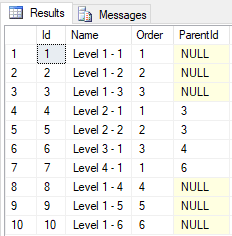Database Table:
I tried this approach to map the category table to EF core:
protected override void OnModelCreating(ModelBuilder modelBuilder)
{
modelBuilder.Entity<Category>(entity =>
{
entity
.HasMany(e => e.Children)
.WithOne(e => e.Parent)
.HasForeignKey(e => e.ParentId);
});
}
Entity:
[Table("Category"]
public class Category : EntityBase
{
[DataType(DataType.Text), MaxLength(50)]
public string Name { get; set; }
public int? ParentId { get; set; }
public int? Order { get; set; }
[ForeignKey("ParentId")]
public virtual Category Parent { get; set; }
public virtual ICollection<Category> Children { get; set; }
}
Then in the repository:
public override IEnumerable<Category> GetAll()
{
IEnumerable<Category> categories = Table.Where(x => x.Parent == null).Include(x => x.Children).ThenInclude(x=> x.Children);
return categories;
}
This worked but anything after 3 levels was not returned no matter how many times you call Include() or ThenInclude().
I ended up writing the code myself to populate the child categories with a recursive function:
public override IEnumerable<Category> GetAll()
{
IEnumerable<Category> categories = Table.Where(x => x.Parent == null).ToList();
categories = Traverse(categories);
return categories;
}
private IEnumerable<Category> Traverse(IEnumerable<Category> categories)
{
foreach(var category in categories)
{
var subCategories = Table.Where(x => x.ParentId == category.Id).ToList();
category.Children = subCategories;
category.Children = Traverse(category.Children).ToList();
}
return categories;
}
Does anyone know a better way to write a stored procedure to get the table hierarchy and map to the Category entity I have provided in the example?

